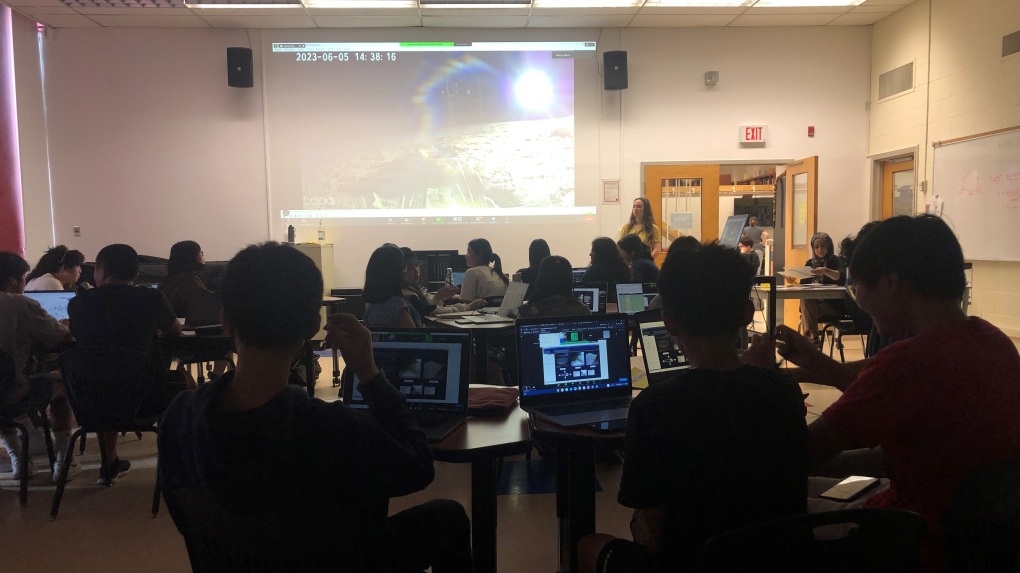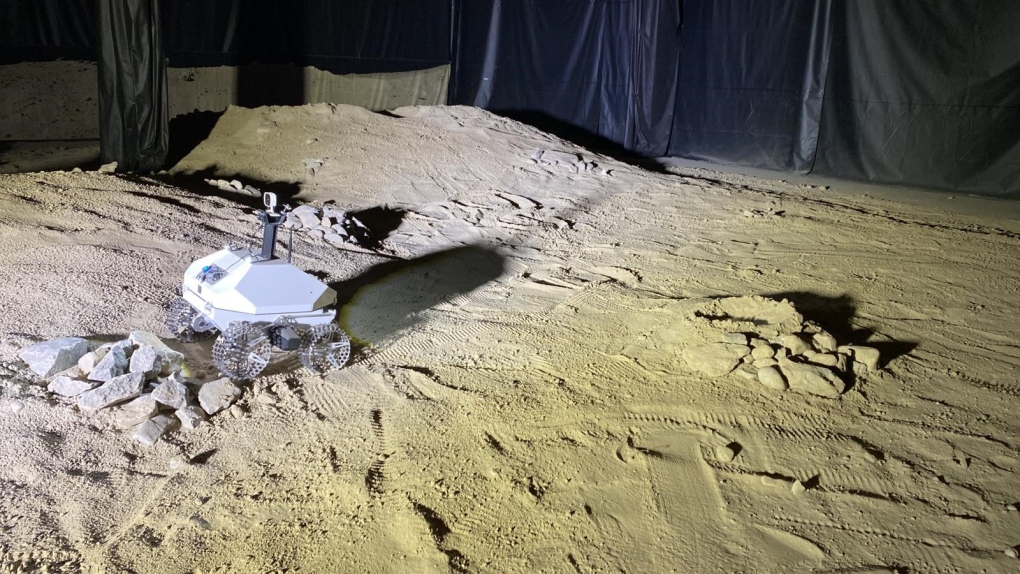Toronto students drive Canadian lunar rover prototype headed for moon exploration
Students from three Greater Toronto Area schools won a national competition to experience what it’s like to remotely control a lunar rover.
“I never knew anything about space or lunar rovers before so it was really fun to know that I won this competition,” Manvi Lakhani, a Grade 9 student at Bayview Secondary School in Richmond Hill, told CTV News Toronto Monday.
“I think the coolest part is that you’re literally on the moon, virtually, and you’re driving a rover on the moon without being there,” she said after taking control of the rover’s movements.
Lakhani was one of a handful students who won the Lunar Rover Research Challenge from education charity Let’s Talk Science after dozens of submissions from across the country. Students from Fallingbrook Middle School and Bristol Road Middle School in Mississauga were also chosen.
The students were given a mission — to use the rover to find ice on the moon. The drivers’ classmates were their support staff. Their job was to figure out which direction to take the rover, track battery life and temperature, and identify the right type of rocks to locate the ice. The first task was finding where the lunar rover had been dropped.
“We took 20 minutes to find it,” said navigator team member and Grade 9 student Tim Liu with a laugh.
“We used our orbital photos. We probably should have turned {the rover} first to see our surroundings, and we used one of our valuable resources to do it. After a while we figured it out.”
 Students from the Greater Toronto Area test out a lunar rover prototype headed for moon exploration. (Beth Macdonell)
Students from the Greater Toronto Area test out a lunar rover prototype headed for moon exploration. (Beth Macdonell)
The current lunar rover is located in a Stratford, Ontario, but the look of the terrain, the feel of the machine, and its challenges are similar to what operators will encounter on the moon.
Moving the rover takes a lot of time and work, said Leah Davis-Purcell, who was leading the simulation and is a technical systems and outreach worker with start-up Avalon Space.
“A two-hour session brings like 50 metres travel or way less than that, because there is so much conversation, thinking and consideration that goes into every move,” she explained.
In a few years, a possible version of the same lunar rover, which is being developed by Canadian engineers Canadensys Aerospace, will be part of the Artemis space missions to the moon. This version could be in action as early as 2026.
“I feel like I’m helping somehow. It feels like I’m making some kind of impact towards the future,” said Cassie Pang, who is in Grade 9 and was a member of the scientists team.
“I’m really happy because I’ll be part of history, slightly,” said Brian Xue, also with the scientists team. “I can say I helped scientists get to the moon.”
 A lunar rover prototype is seen in this undated photograph. (Photo courtesy of Canadensys Aerospace)
A lunar rover prototype is seen in this undated photograph. (Photo courtesy of Canadensys Aerospace)
About halfway through the simulation, the students at Bayview Secondary School were successful and located the ice on the moon.
The project is made possible through funding by the Canadian Space Agency.
CTVNews.ca Top Stories

'They needed people inside Air Canada:' Police announce arrests in Pearson gold heist
Police say one former and one current employee of Air Canada are among the nine suspects that are facing charges in connection with the gold heist at Pearson International Airport last year.
House admonishes ArriveCan contractor in rare parliamentary show of power
MPs enacted an extraordinary, rarely used parliamentary power on Wednesday, summonsing an ArriveCan contractor to appear before the House of Commons where he was admonished publicly and forced to provide answers to the questions MPs said he'd previously evaded.
Leafs star Auston Matthews finishes season with 69 goals
Auston Matthews won't be joining the NHL's 70-goal club this season.
Trump lawyers say Stormy Daniels refused subpoena outside a Brooklyn bar, papers left 'at her feet'
Donald Trump's legal team says it tried serving Stormy Daniels a subpoena as she arrived for an event at a bar in Brooklyn last month, but the porn actor, who is expected to be a witness at the former president's criminal trial, refused to take it and walked away.
Why drivers in Eastern Canada could see big gas price spikes, and other Canadians won't
Drivers in Eastern Canada face a big increase in gas prices because of various factors, especially the higher cost of the summer blend, industry analysts say.
Doug Ford calls on Ontario Speaker to reverse Queen's Park keffiyeh ban
Ontario Premier Doug Ford is calling on Speaker Ted Arnott to reverse a ban on keffiyehs at Queen's Park, describing the move as “needlessly” divisive.
'A living nightmare': Winnipeg woman sentenced following campaign of harassment against man after online date
A Winnipeg woman was sentenced to house arrest after a single date with a man she met online culminated in her harassing him for years, and spurred false allegations which resulted in the innocent man being arrested three times.
Woman who pressured boyfriend to kill his ex in 2000s granted absences from prison
A woman who pressured her boyfriend into killing his teenage ex more than a decade ago will be allowed to leave prison for weeks at a time.
Customers disappointed after email listing $60K Tim Hortons prize sent in error
Several Tim Horton’s customers are feeling great disappointment after being told by the company that an email stating they won a boat worth nearly $60,000 was sent in error.
































